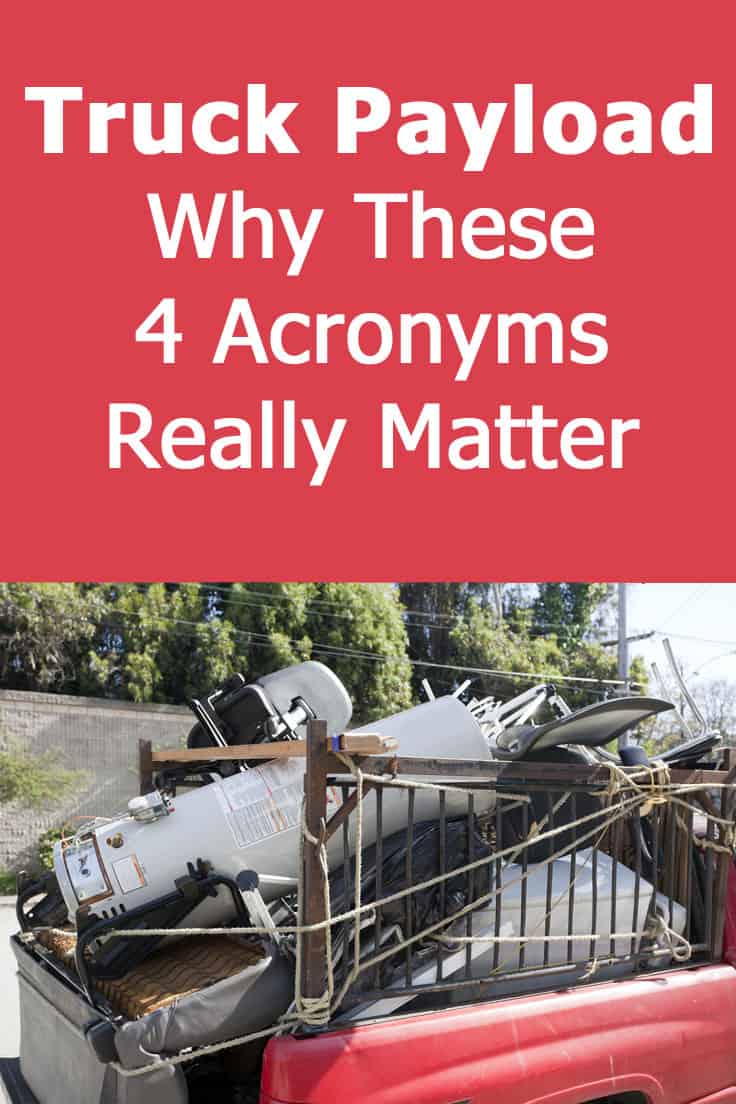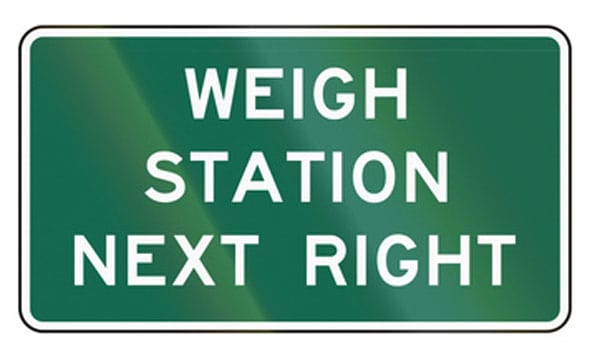
Thinking of buying a pickup truck and looking into specs? Confused by the term "payload capacity"? Between the truck's weight, towing capacity and other details, it certainly can get confusing.
Here's the answer you're looking for -
Payload capacity simply means the weight that your truck can carry - without towing. Payload capacity simply refers to everything that you can put on your pickup (including people, gear and gas, water and oil in the tanks).
There a few more numbers that you should be aware of in this context. In this post, we're going to cover the ways to figure out your truck's payload capacity, as well as how it relates to the alphabet soup of truck weights: GVW, GCW and GVWR.
Why is it important to know your truck's payload capacity?
You want to use a heavy vehicle like a pickup truck safely. For your own safety, that of your family, and other motorists of the road, you need to have full control over your truck and a comprehensive understanding of your truck's limitations.
Trucks are built specifically to carry and tow heavy weights, but different classes have different limitations.
The most essential of limitations is that of payload capacity. That's actually the number that determines which class a pickup truck belongs to: Half ton, 3/4 ton or 1 ton. A light duty truck will have a far smaller payload capacity compared to a heavy-duty truck.
So what does the payload mean? What does it have to do with towing? Or with curb weight? Or the other numbers surrounding a pickup. Let's d(r)ive right in and find out.
What Is Truck Payload?
Every vehicle has what’s known as payload, whether it’s a car, truck, an aircraft, or even one of Elon Musk's rockets.
Payload is simply the maximum amount of weight that can be brought aboard that vehicle. In the case of trucks, this will include:
- The driver
- The passengers
- All gear, equipment, and other items in the vehicle.
- The gas or diesel in your tank
In short, anything that the truck didn't have in it when it left the factory.
Any items in your truck, whether they weigh less than a pound or even several hundred pounds, will all contribute towards the payload.
Both the contents of the truck’s bed and cab are included when determining payload, so this number can get pretty high when you factor in a cab full of passengers and gear in the bed.
What happens if you go over your payload capacity?
If you go over your maximum payload capacity, all kinds of bad things can happen. Depending on how the excess weight is distributed, you will find that maneuvering the truck is harder. If you go uphill or downhill, or drive on wet, slick or icy roads, that alone could cause you to lose control of the vehicle.
Which why it's also illegal.
And if that's not enough to deter you from going over the payload capacity, consider the damage to your truck. Your truck's body, axles, and entire chassis are built to withstand a certain weight. When you go over that, they experience more wear and tear than usual.
How to tell what your truck's payload capacity is?
You can’t just guess what your truck’s payload capacity is. You also can’t necessarily rely on the information you found in advertisements.
The easiest way to find out what your truck's payload capacity is would be to look at official data by the manufacturer. This can be found in the vehicle's handbook or the official manufacturer's website. Make sure you're looking at the exact make, model and year.
The other way to determine payload would be to check your GVWR and the truck's curb weight. Not sure what that means? Read on.
Other Terms related to Payload Capacity
Here are some other numbers that you should get to know. They all relate to payload and you're likely to come across them when shopping for a truck or a towable travel trailer. They include GVWR and curb weight, so knowing them will allow you to calculate a truck's payload capacity.
Curb Weight
Curb weight is basically the weight of the truck, as delivered to you from the manufacturer. It includes all of the standard equipment for that model, as well as any fluids required to run the engine (oils and coolants). In some cases - though not all - it includes a full gas tank. It's also worth knowing another term: Dry weight. As the name implies, this is the weight of the vehicle without any of the consumable liquids.
Fun fact: European car manufacturers include the weight of the driver when calculating curb weight. In case you're wondering, said fictitious driver weighs 165 lbs.
Gross Vehicle Weight (GVW)
When your truck is totally full, adding in passengers, cargo, a full gas tank - everything! - then you have the Gross Vehicle Weight.
The Gross Vehicle Weight or GVW includes passenger weight, cargo weight, and base curb weight. The base curb weight is all equipment that comes with your truck, including a filled gas tank, but not equipment, cargo, and passengers. Usually, the reliable way to figure out the real number is by weighing everything and everyone.

Gross Vehicle Weight Rating (GVWR)
So, now that we've established what GVW is, it's time to talk about GVWR.
The GVWR is simple the maximum GVW that the vehicle is built for. Your GVW should never be higher than your GVWR because then you're overloading the vehicle.
How to know what's your pickup truck's GVWR is?
The GVWR is a crucial number and as such it's usually easy to find. Here's where to find out your truck's GVWR -
- On that sticker with all the numbers in small-print on the vehicle's door frame.
- In the Owner's Manual.
- In the manufacturer's website (or by calling them).
So what's our payload?
With all those abbreviations in mind, you can now go about calculating the truck payload. Here’s the formula: GVWR–curb weight=truck payload.
You should be able to figure out the GVWR and curb weight just by flipping through your truck’s owner’s manual or going online. You can also use the info above. Once you know the payload of your truck, you shouldn’t surpass it. That’s how you severely damage the vehicle.
Gross Combination Weight (GCW) and GCWR
Finally, we're adding everything together to get the GCW or Gross Combination Weight!
Which basically means everything we talked about so far plus a trailer.
GCW includes the trailer when it’s full as well as the GVW. Basically, that's the maximum weight - in total - your truck is allowed to move along the road. Including itself, cargo, passengers, towed trailer... everything.
This is what you end weighing in the weight station -
And here how it all works in a single infographic -

What does payload have to do with towing?
Quite a lot, as it turns out.
A truck also has a towing capacity number, which is separate from the payload. Towing capacity or Maximum Tow Rating (MTR) is basically how much your truck can tow. That's for a hitch as well as a trailer or 5th wheel and everything that's in them.
Auto manufacturers have carefully calculated MTR for each model of pickup truck. Tow rating also changes according to the way you tow, with conventional (trailer) towing having slightly lower MTR compared to gooseneck towing. You have to check the MTR for your specific model and towing method.
For example, a Ford F-250 can have an MTR of 13,000 to 18,500 depending on the exact model and towing method. And since F-150 is the most popular truck in the US right now, we wrote an entire post about how much an F-150 can actually tow.
The thing to remember is that when you're towing a 5th wheel, you also have a significant weight that's placed on top the bed of the truck. The towing pin/hitch is literally on the truck and not behind it.
Which means your pin weight now goes into your payload calculations. So, payload does come into play when you're planning on towing a 5th wheel.
But is Payload Capacity the Same as Towing Capacity?
Here is a question that comes up a lot for those comparing pickups and other heavy-duty trucks: are payload capacity and towing capacity interchangeable terms? The answer is definitely not!
Payload is the maximum weight your truck is allowed to take on - in addition to its own curb weight - on top of the truck's frame and chassis. Sometimes you will see it referred to simply as a truck’s “payload,” while in other instances it’s called the “payload capacity.” These two terms are indeed interchangeable and will typically only vary from manufacturer to manufacturer.
Towing capacity has a totally different meaning than payload capacity. As you now know, you get the payload capacity by subtracting the curb weight from the GVWR.
Some more about towing capacity
First, let’s start with a definition. The towing capacity is the towing limit for your pickup truck. The tongue weight comes back into play here, as this is a calculation of the weight that must be applied to the hitch on your truck.
Too little tongue weight and you could experience trailer sway, where the trailer can skid off the road. Too much tongue weight and steering becomes a challenge. As a rule of thumb, tongue weight shouldn’t exceed 15 percent of the trailer weight. That should allow you to minimize trailer sway and driving difficulties (at least as far as the hitch is concerned).
Know your truck
From the Gross Vehicle Weight Rating to the towing capacity, truck payload, and everything in between, every single one of these numbers matter. These aren’t mere guidelines in which to follow for driving safety, but also legal requirements.
Take some time to learn the specs of your truck and don't go overboard. In fact, it's best to stay well under your limits, for the best and safest driving experience - even when hauling or towing. You wouldn’t want to spend thousands of dollars because you didn’t crunch some numbers, would you?
And if your payload capacity isn't enough - then it isn't enough. Either put less stuff in the truck or upgrade to a stronger pickup.
